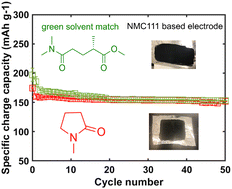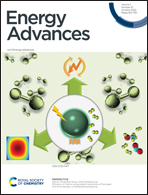PolarClean & dimethyl isosorbide: green matches in formulating cathode slurry†
Abstract
In this study, two green organic solvents are reported in LiNi1/3Co1/3Mn1/3O2 (NMC111)-based slurry preparation and subsequent cathode fabrication for Li ion batteries. NMC111, conductive carbon and poly(vinylidene fluoride) binder composite slurries prepared with methyl-5-(dimethylamino)-2-methyl-5-oxopentanoate (PolarClean) and dimethyl isosorbide (DMI) exhibit mechanically stable, crack-free uniform coating structures. Both slurries showed similar shear-thinning viscosity behavior that suggests similar processibility during electrode casting and coating. When used as the cathode in Li/NMC111 half cells, the electrode slurries prepared with PolarClean show promising electrochemical performance metrics with an average specific charge capacity of 155 ± 1 mA h g−1 at C/10 over 100 cycles, comparable to the films (152 ± 3 mA h g−1 at C/10) prepared with traditional N-methyl pyrrolidone (NMP) solvent. The use of PolarClean points to a potential route to replace toxic NMP in cathode fabrication without altering the manufacturing process. However, electrodes prepared with DMI demonstrate inferior electrochemical performance with an average charge capacity of 120 mA h g−1. Nonetheless, DMI may still offer some promising features and warrants further detailed investigation in terms of compatible electrolyte, tailoring the slurry preparation, and casting conditions.



 Please wait while we load your content...
Please wait while we load your content...